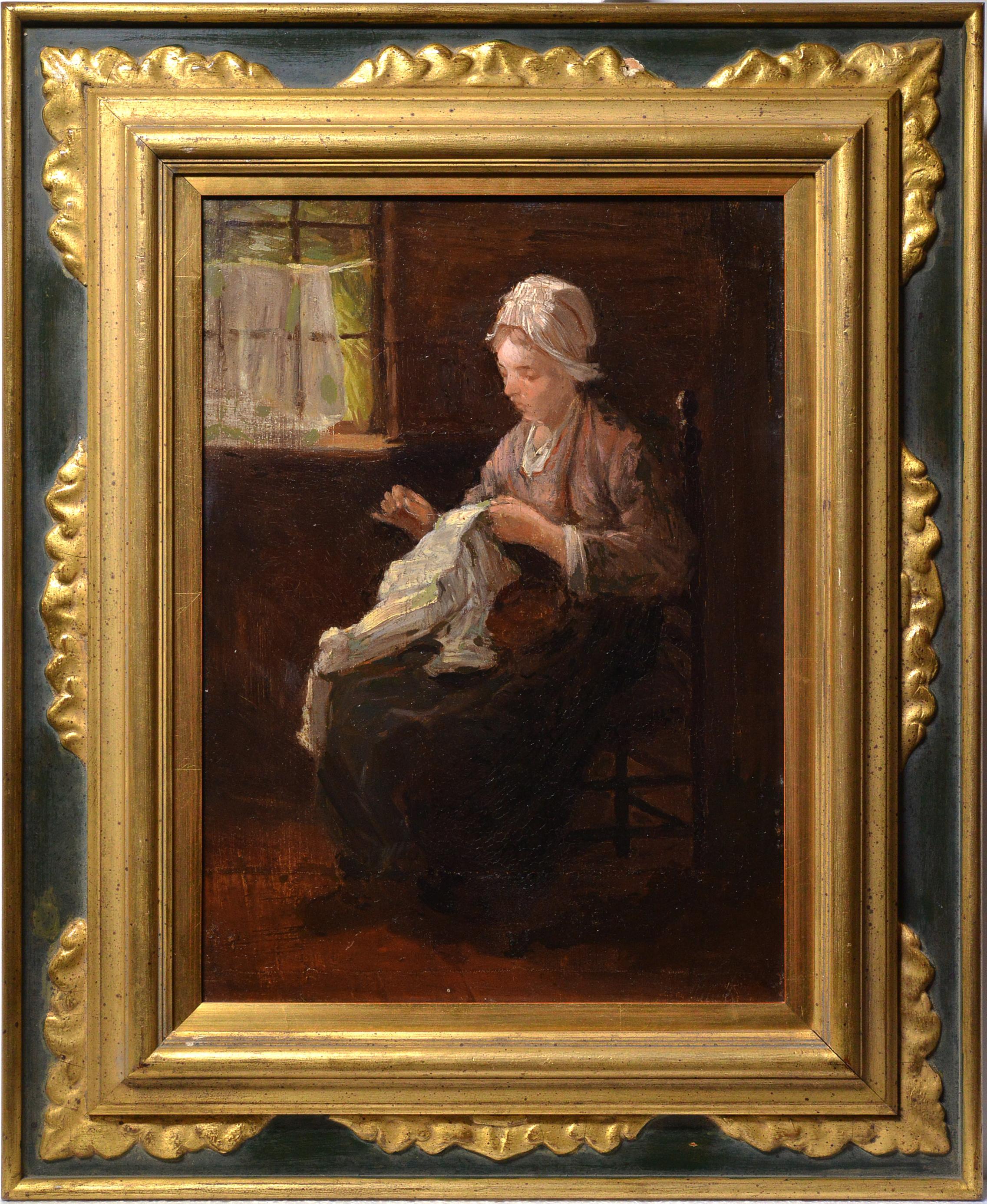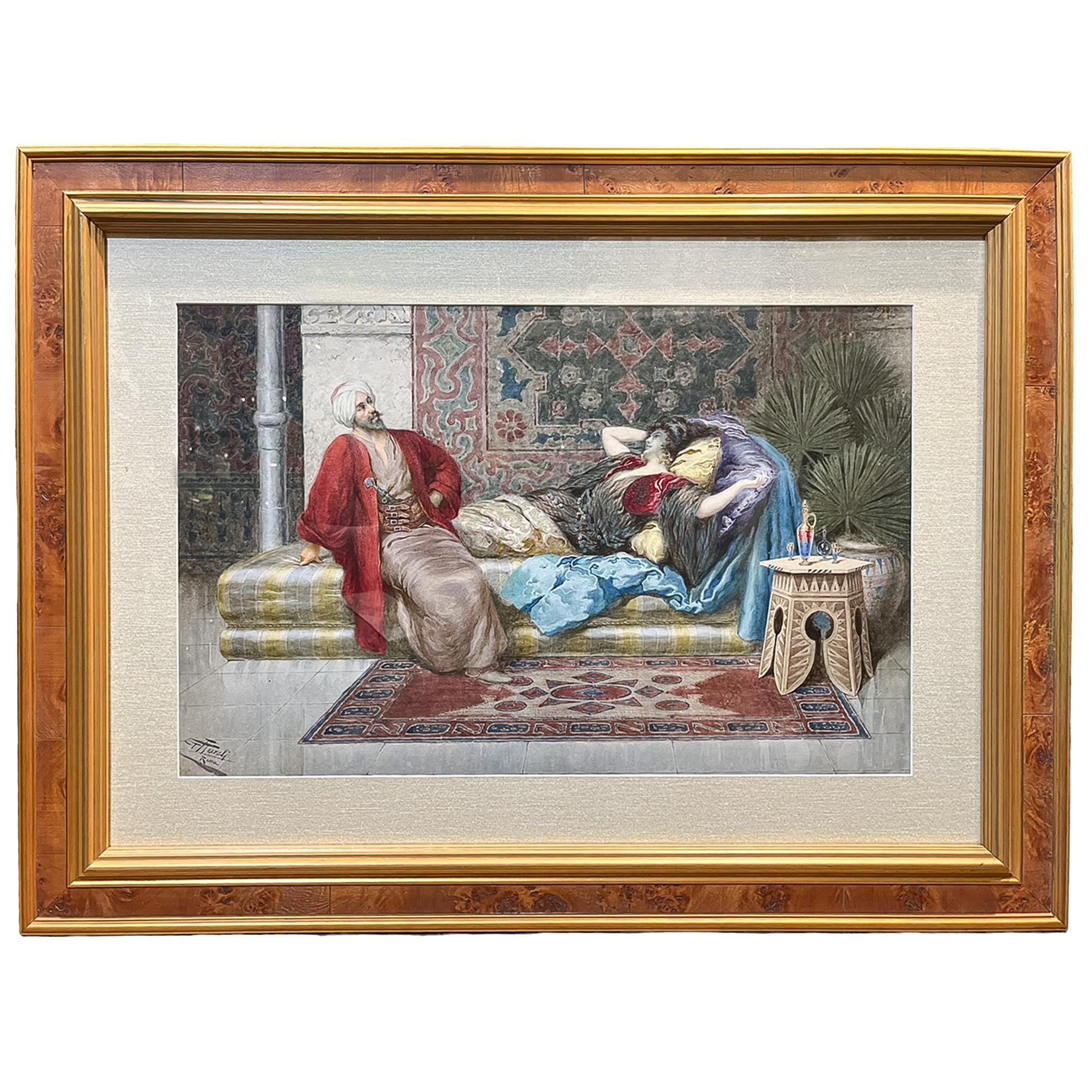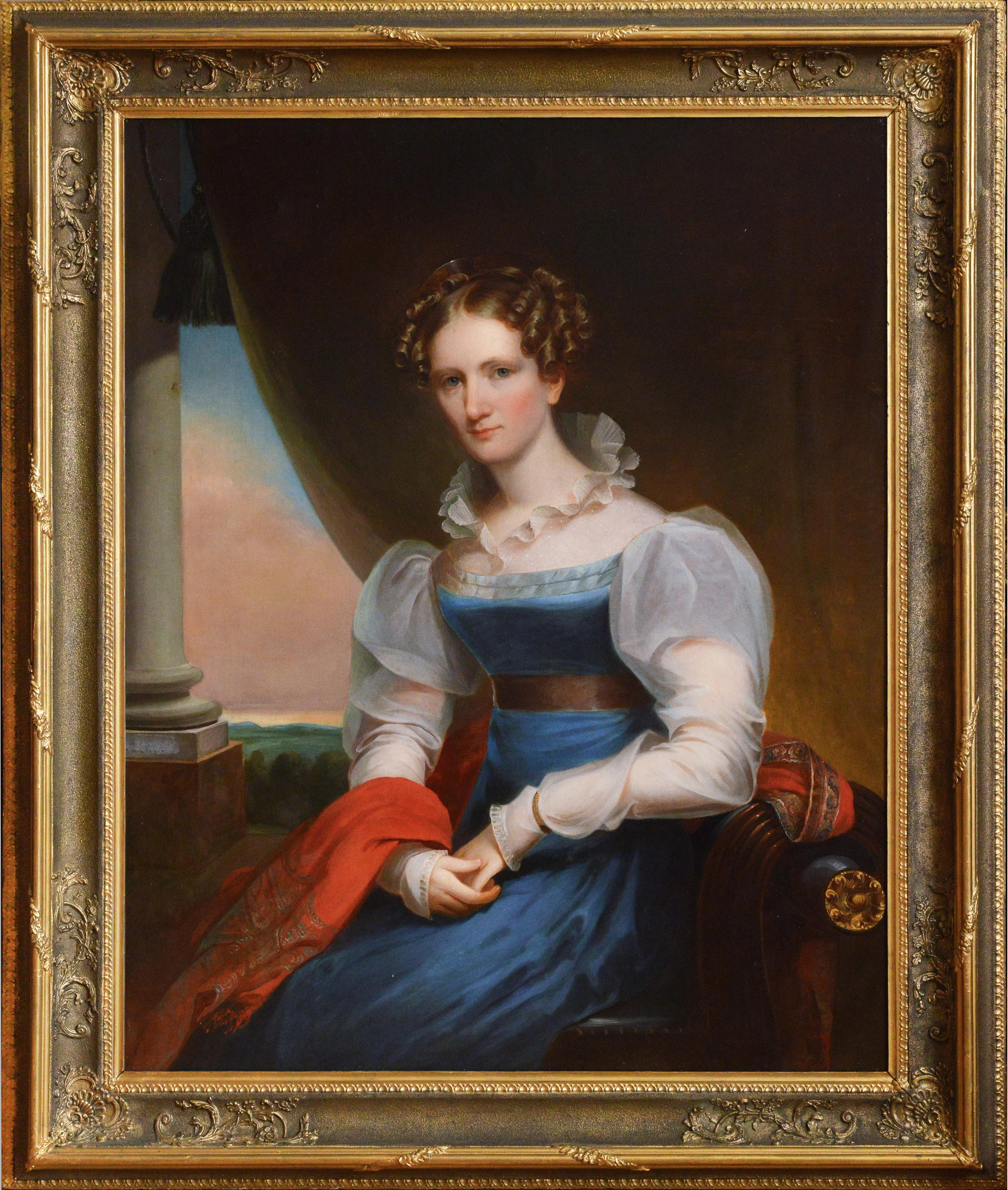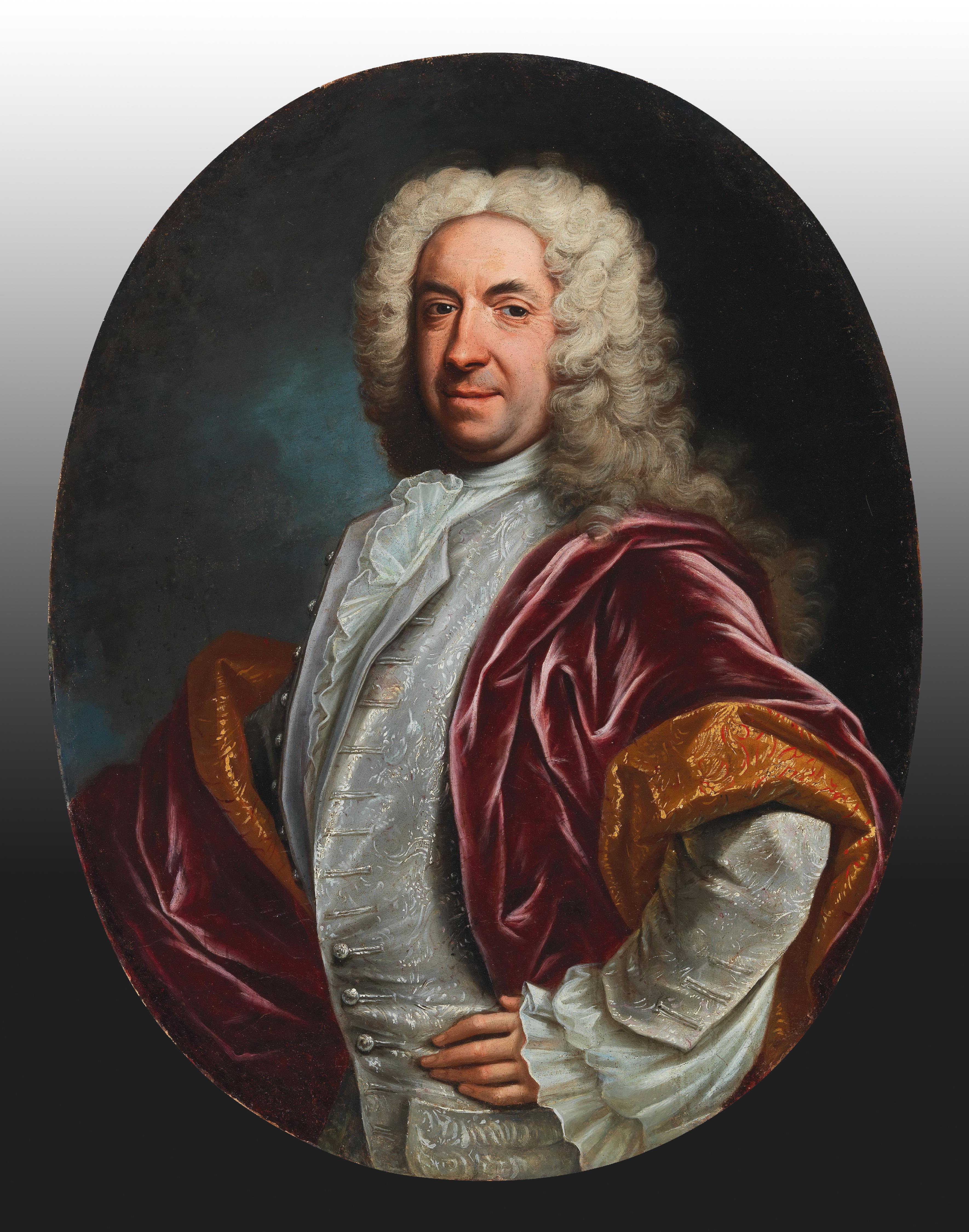Items Similar to Brotherly Love
Want more images or videos?
Request additional images or videos from the seller
1 of 5
Jacob Simon Hendrik Kever Brotherly Love circa 1990
circa 1990
About the Item
signed in the lower right Kever
watercolor on paper
19 3/16 x 17 1⁄8 inches (49.2 x 43.7 cm.)
PROVENANCE
Dr. Katherine Kromm Merritt, Stamford, Connecticut, until circa 1990, from whom acquired by
Private Collection, Vinalhaven, Maine, until 2015
In the warm morning glow of a country kitchen, a young boy entertains his little sister seated in a high chair. In return her adoring glance speaks volumes. The dramatic angling of the baby’s high chair, whose design harks back to the seventeenth century, animates the scene. Through an economy of means and a limited palette of largely brown and orange, Jacob Simon Hendrik Kever captures the richness of the moment and its idyllic rusticity.
Josef Israels was the first to encourage Kever to study painting. He began his training at the Koninklijke Academie voor Beeldende Kunsten, Amsterdam, in 1869, studying with Petrus Franciscus Greive until 1872. From 1874 - 1875 he attended the Rijksakademie van Beeldende Kunsten, also in Amsterdam. From 1878-1879 under the tutelage of Charles Verlat he was enrolled in the Koninklijke Acaemie voor Schone Kunsten in Antwerp. His subjects included portraits, cityscapes, landscapes, flowers, genre and interior scenes in watercolors, oils, and etchings. Throughout his career he worked in Blaricum, Nunspeet, the province of North Brabant and Eemnes. Although not technically considered a member of the Laren School he also lived there from 1877-1879 and again in 1905-1922. He further maintained an apartment in Amsterdam near the Oosterpark where he resided during the winter months. The area must have constituted somewhat of an artist’s community as his neighbors were Geo Poggenbeek, Nicolaas Bastert and later Willem Witsen, Isaac Israels, and George Hendrik Breitner. Painting sojourns were made to the forest of Fontainebleau and the Harz Mountains. He was a member of Arti et Amicitiae in Amsterdam. Until at least 1910 he exhibited at shows in Arnhem, Amsterdam, The Hague, Munich, Paris, Rotterdam, St. Louis, and Venice, winning several gold and silver medals. Kever’s paintings formed part of the permanent collections of the museums of Albany, Amsterdam, Brooklyn, Brussels, Dordrecht, Haarlem, The Hague, Heino, Kampen, Laren, Middelburg, and Toledo, Ohio.
It was scenes such as this depicting Dutch cottage interiors filled with sunlight that brought Kever lasting fame. The young boy’s attire confirms the setting as the Gooi region where Laren is located. Although inspired by Israels, who is credited for “discovering” Laren, it would be Albert Neuhuys’ work that ultimately had the strongest impact on Kever and who is regarded as “the true founder of the Laren School”. By the end of the nineteenth century a large art colony had formed in the village. In 1903 an anonymous writer for the Toledo Daily Blade newspaper described Laren’s appeal, “Holland, like the rest of the world is gradually changing, and much of the old and picturesque is passing away. The old stone floors are being supplanted by wooden ones and the great fire places are falling into disuse through the introduction of crude and inartistic cast-iron stoves. However Laren has been lightly touched by the hand of time, and while there have been some changes to conform with modern times, they are in the main but trivial and consequently it is an ideal spot for the artist”. The population consisted of weavers, laborers, and sheep farmers, living in dwellings whose secluded and serene atmosphere fascinated artists. Besides Neuhuys, Lammert van der Tonge, Willy Sluiter, Lion Schulman, and Jacob Dooijewaard were among other artists working in the area.
Neuhuys concentrated on cottage interiors that featured the traditional lifestyle of the village. Lacking Josef Israels’ penchant for drama, his scenes are ones of contentment. In what has been described as a “frankness of manner” his handling is looser and more atmospheric. Kever followed Neuhuys’ lead but employed a more vivid palette. The immediacy of the imagery of works such as Brotherly Love stems from the medium. At his best in watercolor, the reason for this was clarified in an exhibition catalog devoted to Kever by Gebroeders Binger of Amsterdam. “How many times he made, under the superior impression of some sublime subject, an excellent and successful study or sketch, being filled with a feverish desire to give back what he had seen as sensitive and as complete as possible – but how many times there followed for the artist so discouraging disappointment that gradually during the working up to a picture, the superior qualities of the original study were lost”. What further differentiated Kever from Neuhuys was a lack of sentimentality. Contemporary viewers felt “the children of his brush are real children, lovingly and yet realistically rendered” and this is exactly why Kever’s Brotherly Love resonates today. Basked in warm colors, devoid of pretense while stripped to its emotional core, it is a profound portrayal of innocence.
- Creator:Jacob Simon Hendrik Kever (1854 - 1922, Dutch)
- Creation Year:circa 1990
- Dimensions:Height: 19.38 in (49.2 cm)Width: 17.21 in (43.7 cm)
- Medium:
- Movement & Style:
- Period:
- Condition:Please contact us for a Condition Report on this work.
- Gallery Location:New York, NY
- Reference Number:1stDibs: LU2558212463132
About the Seller
No Reviews Yet
Vetted Seller
These experienced sellers undergo a comprehensive evaluation by our team of in-house experts.
Established in 1989
1stDibs seller since 2023
- ShippingRetrieving quote...Ships From: New York, NY
- Return PolicyThis item cannot be returned.
More From This SellerView All
- At Grandmother’sLocated in New York, NYsigned in the lower left Artz oil on canvas 26 x 19 ⅝ inches (66 x 50 cm.) PROVENANCE D. Sala & Zonen, Leiden , prior to 1936 Private Collection, Florida, circa 1968 until the present time Much like their seventeenth century counterparts, a group of painters known as the Hague School in the 1870s came to embrace as their subject matter the native Dutch landscape and the everyday lives of its rural inhabitants, most notably the fisher folk of the coastal villages. Within ten years the Hague School artists’ works would prove so popular that incredibly a mania for all things Dutch would be felt throughout the world, and would dominate the art in Holland until well after the turn of the century. By embracing simple themes remarkable for their ordinariness, the Hague School succeeded in striking a chord with a public whose own placidity was constantly being rattled by the evolving modernity of the times. Conveyed through the employment of subtle tones, hazy skies and subjects of happenstance their mix of nostalgia and realism enchanted viewers. The Hague became the center of the movement because it was semi-rural surrounded by meadows, polders, waterways, dunes and woods, and nearby Scheveningen provided a wealth of material for artists seeking to paint the shore and its fishing community. Jozef Isräels was considered the dean of the Hague School and David Adolphe Constant Artz his most important follower. Artz began his training in 1855 at the Amsterdam Academie under Louis Roijer and Johannes Egenberger, and would remain in Amsterdam until 1864. During this period, he would be influenced by August Allebé but more importantly a lifelong friendship with Jozef Israëls formed. In 1859 they traveled together to Zandvoort. He would also be the first of the Hague School artists to follow Isräels’ lead of working on the beach at Scheveningen. In 1859 Artz publically exhibited for the first time, taking part in the Tentoonstelling von Levende Meesters (Exhibition of Living Masters). In 1864 he left Amsterdam to live in Zweeloo, Drenthe for a year. From 1866 until 1874 he shared a studio with Jacob Maris and Frederick Hendrik Kaemmerer. He was one of the first of the Hague School artists to work in Paris (Jacob Maris having preceded him by one year) enabled by his patron and benefactor Johannes Kneppelhout. Artz created quite a commotion upon his arrival by including in his baggage a large collection of Scheveningen peasant costumes. As previously in Holland, Artz during his sojourn in Paris continued to paint beach scenes and interior views that featured the fishing communities of the North Sea. During this period Artz became interested in Japanese prints which had recently become available in Paris, and painted a few genre scenes of interiors with Japanese décor and subjects. While based in Paris he also traveled to Scotland from May-June 1869, Germany in November of that year, England in 1870 and Italy in January, 1872. By 1874 he returned to the Netherlands to live permanently in The Hague. Artz in his own time was held in high esteem by the public as well as his fellow artists. He was awarded gold medals at exhibitions in Munich and Vienna, as well as a Diploma and Medal of Honor in Dresden. In 1879 he was made Knight of the Oaken Crown of Luxembourg and in 1889 also became a Knight of the Order of St. Michael of Bavaria. In 1880 he received an Honorable Mention at the Salon in Paris and won a gold medal in 1883 at the International and Colonial Exhibition, Amsterdam. In Paris he was a member of the Société Nationale des Beaux Arts and a Chevalier of the Legion of Honor by 1889. He also served as Vice President of the International Jury of Award at the 1889 Exposition Universelle, Paris. In 1893 four works by Artz were chosen to be included in the World’s Columbian Exposition, Chicago. An American reviewer wrote of this show “The works of giants like Rembrandt, Van der Neer, Ruysdael, Holbein and Franz Hals are almost equaled now by masters like Israels, Mesdag, Bosboom, Maris, Mauve and Artz”. Artz’s entries A Girl Knitting, The Pet Lamb, Idle Hours on the Dunes and Girl Sleeping on the Dunes were listed under the category of “Immortal Works”. His works formed part of museum collections of Amsterdam (Rijksmuseum and Municipal Museum); Cambridge, England; Chicago; Dordrecht; Glasgow; Haarlem; The Hague (Gemeentemuseum and Mesdag Museum); Leewarden; Montreal; New York (Brooklyn and the Metropolitan Museum); Oxford; Rotterdam; St. Louis; Tulsa and Zandvoort. Much enamored with the picturesque dwellings of the rural population, a favorite subject of the Hague School was the depiction of a family group gathered around a table sharing a simple meal. Ronald de Leeuw in his introduction for The Hague School Book remarked that the group “derived poetry from a view of the kitchen”. Artz excelled at this type of interior scene in which every detail has been carefully recorded in emulation of his seventeenth century predecessors. Vincent van Gogh, an admirer of the Hague School in general and Artz in particular, wrote to his brother Theo in a letter dated Etten, Friday, August 26, 1881 about an exhibition in The Hague he had just visited in which he described a drawing by Artz of an “old man and woman eating porridge, very important, very good and serious.” There is a large version of At Grandmother’s (131.5 x 91.5 cm.) in the Rijksmuseum, Amsterdam. It was painted in 1883 and shown in an exhibition in The Hague in 1884 where it was purchased by the museum. This undoubtedly must have sparked interest in the composition and created a demand for the image to be replicated as several versions of the composition in varying sizes are recorded, and Artz was known for executing repetitions of his own works. Regarded as one of the highlights of the collection in the Philbrook Museum of Art in Tulsa, Oklahoma is another version by Artz of At Grandmother’s. The iconic nature of the image must have appealed to contemporaries as the perfect summation of the mix of idealism and realism that characterized these artists and their times. In a cottage under a wooden beamed ceiling a grandmother with her two granddaughters clothed in the traditional garb of Katwijk (where the artist spent his summers and maintained a cottage in the dunes) sit on wooden chairs around a gate-leg table in a kitchen sharing a simple meal of bread and an apple. The grandmother carefully slices a piece of bread while the younger girl looks on expectantly. Her sister sips milk from a small delftware bowl watching...Category
Mid-19th Century Dutch School Interior Paintings
MaterialsOil
- Two SistersBy Flemish School, 17th CenturyLocated in New York, NYoil on canvas 46.7 x 37.2 inches (118.5 x 94.5 cm.) PROVENANCE Private Collection, Isle of Wight Two young sisters are posed on a portico backed by a rotund column with a landscape beyond. Although their identities are unknown their outfits as well as the setting denotes wealth and status. The older sister wears a gown of gold with blue and gold trim raised to reveal a green underskirt also edged with gold. Her collar tied at the neck and fastened over her shoulders by a large rosette of golden cloth, apron and cuffs over wide sleeves, are all of a sheer batiste linen trimmed with lace. Previously a child would not have been painted in a bib or apron above the age of three, but in the 1650s and 1660s it became fashionable for older girls. A leading string hangs from her right shoulder, which is also surprising given her age, but once their utility was gone, they were viewed as a decorative accessory and remained part of children’s costumes...Category
17th Century Old Masters Portrait Paintings
MaterialsOil
- A Boar Hound with a Joint of Meat Near an Enraged CatLocated in New York, NYsigned in the upper right Gio Batta Weenix oil on canvas 45 x 51 inches (114.5 x 129.5 cm.) PROVENANCE (possibly) Giovanni Baptista Weenix estate sale, Huis ter Mey, De Haar, Apr...Category
Mid-17th Century Old Masters Animal Paintings
MaterialsOil
- Joseph McCarthy as Baby New Year on a HobbyhorseBy Reginald MarshLocated in New York, NYink on beige sight size: 254 x 317 mm. PROVENANCE Acquired directly from the artist by Edward Laning (who inherited Marsh's studio) to Jack Henderson...Category
1950s Other Art Style Figurative Drawings and Watercolors
MaterialsPaper, Ink
- A Basset HoundBy Jules MoigniezLocated in New York, NYinscribed J. Moigniez bronze with brown patina, cast during the artist’s lifetime height 18 1⁄2 inches (47 cm.), width 29 1⁄8 inches (74 cm.) PROVENANCE James Graham & Sons, Inc., N...Category
Late 19th Century French School Figurative Sculptures
MaterialsBronze
- A View of Capodimonte and A View of Posillipo in Naples; Two DrawingsLocated in New York, NYPROVENANCE Mortimer Brandt, until 1993 and thus by descent in the family to Private Collection, Baltimore until the present time We would like to thank Charles Beddington for ident...Category
Late 17th Century Old Masters Landscape Drawings and Watercolors
MaterialsPen, Ink, Laid Paper
You May Also Like
- Dutch interior scene Peasant girl sewing 19th century Oil paintingBy Jozef IsraëlsLocated in Stockholm, SESigned bottom right: Jozef Israëls (1824 – 1911). Painting was certified by Pierre Noelmans of Reveil Galerie in Maastricht in early 1970s. Jozef Israëls, was best-known second hal...Category
Late 19th Century Dutch School Portrait Paintings
MaterialsWood, Oil
- A Fine Orientalist Watercolor by Giuseppe AureliBy Giuseppe AureliLocated in New York, NYMiddle Eastern Indoor Scene, watercolor of a man and a reclining woman. Artist: Giuseppe Aureli (1858 - 1929) Origin: Italian Date: 19th Century Medium...Category
19th Century Other Art Style Interior Paintings
MaterialsWatercolor
- Young woman watercolorBy Jordi CurosLocated in Barcelona, BarcelonaJordi Curos - Young woman - Watercolor Watercolor measurements 40x32 cm. Frame measurements 54x46 cm. Jordi Curós Ventura (Olot, Girona, March 4, 1930) is a Spanish painter. He tra...Category
1970s Fauvist Portrait Paintings
MaterialsWatercolor
- American artist Portrait German lady 19th century Oil painting by J. EichholtzLocated in Stockholm, SECeremonial Portrait of Noble German Lady - amazing discovery of hidden monogram "J.E. 1826" disclosing Great American portraitist Jacob Eichholtz (17...Category
1820s Realist Portrait Paintings
MaterialsCanvas, Wood, Oil
- Baroque Portrait of a gentleman 18th century Italian master by Domenico ParodiBy Domenico Parodi (Genoa, 1672 - 1742)Located in Stockholm, SEWe are grateful to Prof. Daniele Sanguineti for suggesting the attribution to Domenico Parodi (1672 - 1742). He dates the painting into the period between 1730 and 1740. Domenico Par...Category
1730s Realist Portrait Paintings
MaterialsCanvas, Oil
- Masquerade oil on canvas painting VeneziaLocated in Barcelona, BarcelonaAntoni Granja Llobet (1954) - Pitita - Oil on canvas Oil measures 73x60 cm. Frameless.Category
1980s Contemporary Interior Paintings
MaterialsCanvas, Oil



